To a dog parent and their dog, crate rest may sound quite daunting. But sometimes it is a necessary evil while a dog is recovering from an injury or surgery. To help your dog stay calm and entertained, integrative veterinarian Dr. Julie Buzby answers five crate rest FAQs and provides nine cage rest tips.
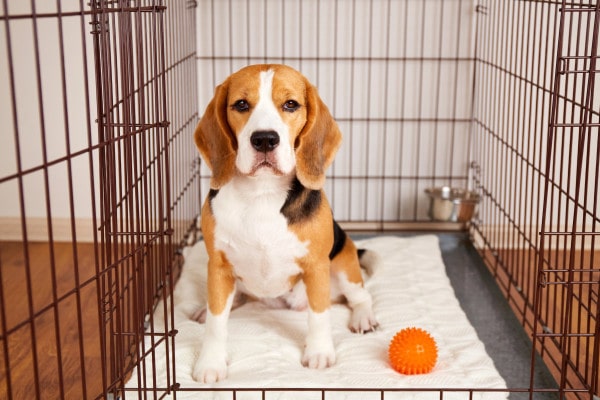
Anytime our dogs get hurt, it can be difficult to know how to help them. But I think this becomes even more challenging when the words “dog crate rest” come out of your veterinarian’s mouth.
Understandably, many dog parents may feel like crate rest is equivalent to doggy detention. They worry that their dog will feel like they are being punished or that their dog will be bored.
However, crate rest is an extremely important part of the healing process for many injured or recovering dogs. To help make it a bit easier for everyone involved, I want to answer five FAQs and share nine tips to help keep your dog calm, happy, and mentally stimulated during dog crate rest.
- What is crate rest for dogs?
- 5 dog crate rest FAQs
- FAQ #1: When should I start crate rest?
- FAQ #2: How do I take my dog outside to go potty during cage rest?
- FAQ #3: How can I entertain my dog while he or she is on crate rest?
- 9 tips for crate rest success
- Crate rest is a team effort
- What have you done to keep your dog comfortable, calm, and sane during crate rest?
What is crate rest for dogs?
Veterinarians usually put injured dogs on crate rest to ensure a dog doesn’t hurt himself or herself further and/or to allow time for proper healing. To ensure we are on the same page, when I say “crate rest” what I mean is having your dog spend multiple days in a cage, crate, or kennel (whatever you want to call it) to heal from an injury or surgical procedure.
It is essentially the equivalent of bed rest for people. But since dogs don’t understand the concept of bed rest, we may need to confine them to a crate in order to keep them from moving around too much.
Strict crate rest can be a part of the treatment plan for many different conditions in dogs, including:
- Intervertebral disc disease (IVDD in dogs)
- Dog leg amputation
- Torn ACL in dogs
- Broken bones
- Torn ligaments
- Conservative management of pelvic fractures in dogs and cats
- After orthopedic or soft tissue surgery (e.g. TPLO surgery for dogs or dog hip replacement)
If your dog needs to be on crate rest for one of those conditions (or something else not on the list), it is important that you follow your veterinarian’s recommendation. I know crate rest doesn’t sound fun. But giving your dog time and the proper environment to heal can help optimize your dog’s recovery.
5 dog crate rest FAQs
Since crate rest is most likely something new for your dog and for you, there can be a lot of logistics to think through. Hopefully, the instructions your veterinarian gave you, plus the answers to these dog crate rest questions and the tips I’ll share in a bit, will help make the task seem less daunting.
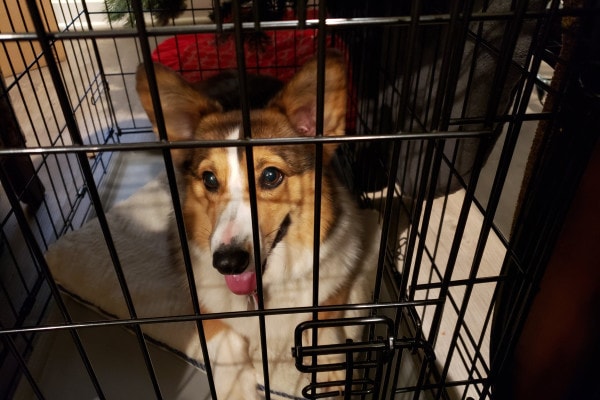
FAQ #1: When should I start crate rest?
If your veterinarian prescribes cage rest for your dog, you should ideally begin it immediately after arriving home from the appointment. The sooner you start confining and resting your dog, the sooner he or she can start healing.
FAQ #2: How do I take my dog outside to go potty during cage rest?
Part of the daily routine, even on crate rest, is taking your dog outside to urinate and defecate. It is important that you give your dog the opportunity to go outside and relieve himself or herself. Understandably, dogs who are house-broken may feel discouraged if they are forced to urinate or defecate in their kennel.
The logistics of taking your dog outside might look slightly different depending on the reason your dog is on crate rest. So you should always discuss this with your veterinarian to understand what is, or is not, allowed for your dog.
Walking on a leash without assistance
For some dogs, it is fine to walk from the crate to the yard on their own on a leash. However, your veterinarian might request that you avoid taking your dog up and down stairs. In this case, you may need to carry your dog on the stairs or create a ramp for him or her. Alternatively, you might be able to put your dog’s crate somewhere that does not require stairs to get outside.
When walking your dog outside, please keep him or her on a 6-foot leash (not an extendable leash or free-roaming). Being on a short leash is important because it allows you to keep control of your dog. That way you can prevent him or her from running around or trying to play when outside.
Remember, you should take your dog outside just long enough to do his or her business. And then as soon as your dog is done, calmly bring him or her back inside. This is not a time to be taking your dog for a true walk.
Walking outside with assistance
Alternatively, your vet may allow your dog to walk outside with assistance. For example, you may have to help your dog walk using a sling or a Help ‘Em Up® Mobility Harness. These tools help you support your dog’s weight and control his or her movements while still allowing your dog to get up and walk outside.
Carrying your dog outside
You may need to carry small dogs or dogs with severe injuries outside to go to the bathroom. If this is the case, ensure you ask your veterinarian how to best carry and support your dog. You don’t want to make the injury or pain worse by carrying your dog improperly.
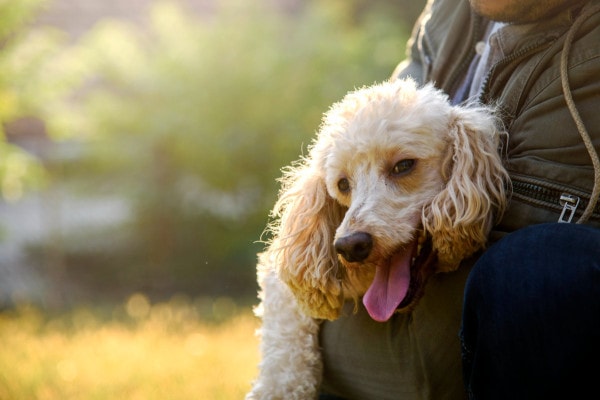
FAQ #3: How can I entertain my dog while he or she is on crate rest?
The number one question clients ask me is, “How can I keep my dog from being bored or going stir crazy while on crate rest?” I get it, which is why I wanted to discuss it here.
Thankfully, there are a lot of dog toys and tools available to help provide enrichment while your dog is in the crate. Here are some of the activities and toys that I consider to be the best for dogs on cage rest:
Brain games
I love brain games for dogs on crate rest. They are a great way to keep the dog’s brain challenged and working. Plus, they are fun for you and your dog to do together.
Brain games can look different for each dog.
For example, you could teach your dog new tricks. Of course, the tricks can’t hinder your dog’s healing or get him or her too excited. But some dogs on cage rest can learn “shake” or “bashful” while in the crate.
Or another one of my favorite “boredom busters” is to teach your dog how to discriminate between two different objects. This is sometimes also called a “name game.” In this game, you hold up two items (like a ball and a different toy) and teach your dog to “nose boop” the item that you name. This is a fun trick for pet parents to show off to their friends. And it is an excellent way to stimulate a dog’s brain.
Food dispensing toys or games
Another way to provide mental stimulation and entertainment for your dog is to provide food dispensing dog toys or games. There are many different options for food dispensing toys on the market. Some of my favorites are dog puzzle or maze feeders. But you can also create your own games at home too. For example, you can use cardboard boxes or blankets to hide toys or food and then have your dog find them.
Just remember to keep the games somewhat simple or low-energy to ensure your dog isn’t moving around too much in the crate.
Spend quality time together
Spending time with your dog is another great way to provide stimulation and enrichment for a dog on cage rest. Your dog is used to being with you throughout the day. So if your dog suddenly never saw you during the crate rest, he or she would probably be confused and sad.
Keep in mind, though, that there are some dogs who become more anxious or overly excited when their parents come by for “home visits.” Therefore, you may need to figure out how to ensure your dog won’t get too wound up or try to move more than he or she should. Keeping your dog calm is the most important part of crate rest after surgery or an injury.
Quality time ideas
When thinking about how to spend time together, consider your dog’s personality. And try to do something you think your dog could enjoy while remaining calm. Some options include:
- Moving the crate into your bedroom at night if your dog is used to sleeping with you.
- Sitting next to your dog’s crate while watching TV or reading a book. Some dog parents even enjoy reading or singing to their dog.
- Using a dog wagon or stroller to take your dog on a walk and get some fresh air outside. (This may be an option if you can safely pick your dog up without further injuring him or her and you think your dog will stay calm and still.)
- Working on physical therapy exercises (e.g. passive range of motion exercises for dogs) with your veterinarian’s approval. This is a great way to provide entertainment and help promote healing and return to function.
- Opening the crate door to pet your dog or give him or her a massage.
Quality time together is going to look different for every dog and person. And it will be heavily dependent on what your veterinarian says your dog can and cannot do while on crate rest. Most of the time though, you are able to find something that works well for you and your dog.
FAQ #4: How do I manage crate rest if I have other dogs in the house too?
If you have more than one dog living in your house, it is okay. Your dog can still successfully be on crate rest.
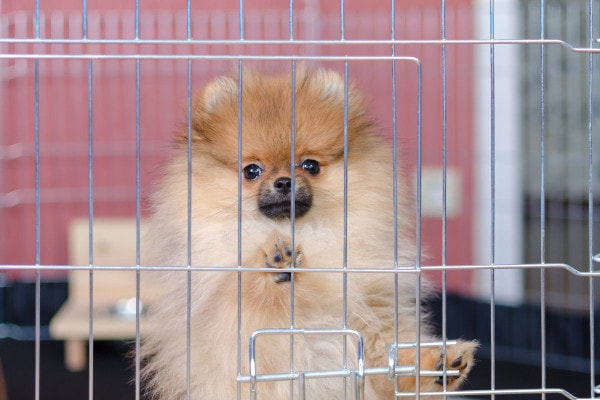
In multi-dog homes, I recommend clients designate a recovery room for the dog who is on crate rest. It should be somewhere you can place your dog in the crate and then shut the door to the room to keep the other pets out.
Plus, the room should be a comfortable and relaxing place for your dog to sleep during his or her time in the kennel. Ensure it has proper temperature control so your dog does not get too hot or cold. The recovery room also should not have abnormally loud noises that might disrupt your dog’s rest. Finally, the room should be somewhere that makes it easy to spend time with your dog while he or she is on crate rest.
Having a separate recovery room ensures the other dogs aren’t trying to take the crated dog’s enrichment activities. Additionally, some dogs can feel territorial when it comes to dog crates—especially if they are spending extended periods of time in them. Providing your dog with some privacy can avoid him or her feeling the need to protect the kennel from the other dogs. And it keeps the other dogs from getting the crated dog worked up.
FAQ #5: What if my dog has separation anxiety but needs to stay crated?
Understandably, many dog parents are worried that their dog won’t stop crying or barking during crate rest, especially if their dog isn’t crate-trained (i.e. accustomed to being in a crate). Or they are concerned their dog could further injure himself or herself in an attempt to escape the crate.
If you know your dog has a history of separation anxiety, or develops separation anxiety during crate rest, the best thing you can do is discuss your concerns with your veterinarian. Ideally, you would be able to work with your vet to create a plan as soon as (or before) you start seeing signs of separation anxiety.
Some dogs feel better if you move their kennel into the same room you are in (within reason). Or other dogs just need extra enrichment and entertainment to relax in the kennel.
But if this doesn’t work, your dog may need medications to help him or her feel less anxious. Depending on your dog’s diagnosis, your dog might be prescribed anti-anxiety medications or sedatives for crate rest. Some of the more common options are trazadone for dogs, fluoxetine, or gabapentin for dogs. But your vet will determine what is right for your dog.
Medications are not the answer for every dog on crate rest. But they can be very beneficial for those who need them. Please don’t be afraid to call your veterinarian if you have any concerns your dog might be developing crate-related anxiety.
9 tips for crate rest success
Providing stimulation, keeping your dog comfortable and relaxed, and following your vet’s instructions during crate rest can go far in helping you be successful. But I have a few other tips I share with clients that I’d like to pass on to you.
1. Use a blanket or bed for comfort in the crate
If your dog will not chew on them, include a thick blanket, cozy bed, or, at the very least, non-slip matting, in the kennel. This can help your dog stay comfortable and relaxed while lying in the crate throughout the day. And it can also help decrease the risk of pressure sores on dogs from spending so much time lying down.
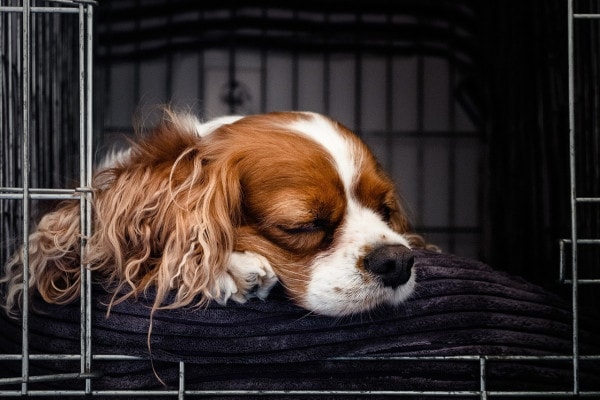
2. Don’t stop crate rest too early
I know it can be challenging, but please do not end your dog’s crate rest early. Stopping too soon or not being strict about it are two of the biggest reasons crate rest fails. It is important to keep your dog in his or her crate the full length of time your veterinarian recommends.
Plus, after the prescribed time, it is usually a good idea to have your vet recheck your dog’s status before ending crate rest. That way you know it is ok to start gradually increasing your dog’s activity level again. (Notice I said “gradually.” Going from crate rest to full activity can potentially cause a big setback in your dog’s healing and recovery.)
3. Find the right level of stimulation for your dog.
Avoid over-stimulating or exciting your dog. As I mentioned above, it is important to provide mental stimulation and entertainment to your dog during crate rest. But you don’t want him or her to be too worked up and risk further injury.
4. Talk to your vet if crate rest isn’t going well.
If your dog won’t relax during crate rest, please consult your veterinarian. Some dogs do need anxiety medications, sedatives, or additional pain medications to be comfortable during crate rest.
Additionally, anytime you have questions or concerns, please reach out to your veterinarian. He or she is familiar with your dog’s situation and treatment plan. So your vet can give the best advice for specific scenarios.
5. Keep an eye on your dog’s weight
Due to decreased activity and movement, some dogs can experience weight gain during kennel rest. So, it is important to monitor food and water intake and assess your dog’s body condition score regularly.
Measuring out your dog’s food is a great way to ensure that you are not feeding too much. But you should also pay attention to how many treats your dog is getting.
I know many dog parents feel bad for their pup who is spending time in the kennel. So they try to make their dog happier by feeding extra treats or snacks. However, this adds a lot of extra calories that your dog doesn’t need—especially when spending most of the day lying down.
Some dog parents find it helpful to work with their vet to calculate their dog’s daily caloric needs. Then they can portion out the appropriate amount of food and treats for the day ahead of time. That way, when they want to give their dog a treat or use food or treats in a puzzle toy, they can pull it from the allotment. This helps avoid falling into the trap of inadvertently giving your dog extra calories from the enrichment activities, plus all the calories from their regular amount of food.
6. Watch for a decreased appetite
On the other hand, it is also important to monitor how much your dog is eating and drinking to ensure he or she is consuming enough food and water. If your dog is in pain from whatever injury is causing him or her to be on crate rest, your dog might develop a decreased appetite.
This is often one of the first, and easiest to notice, signs a dog is in pain. So if your dog stops eating or drinking, please consult your veterinarian to determine if your dog needs a change in his or her treatment plan.
7. Put a “Do not knock or ring the doorbell” sign on the door
If your dog is easily excited or agitated by the sound of people knocking or ringing the door bell, it can be helpful to put a “Do not knock” or “Do not ring the doorbell” sign on the door. This can decrease the chances your dog will jump up and accidentally injure himself or herself further at the sound of someone arriving.
8. Monitor your dog’s surgery site or injury closely
Assess your dog’s surgery site or injury multiple times a day to ensure it is healing properly. Your veterinarian can give you an idea of what to expect after your dog’s particular surgery or injury. But in general, if it seems like the injury is getting worse, please contact your veterinarian immediately.
9. Use the E-collar
If your dog is sent home with a cone (i.e. E-collar), please keep it on him or her at all times. Cones are designed to protect a wound or incision from excessive chewing and licking.
Dogs who are prone to licking or chewing the area are more likely to do so in the crate. So if he or she doesn’t have the E-collar on, your dog could make the injury worse and increase the length of time he or she needs to say on crate rest.

Crate rest is a team effort
I know no one likes the idea of crate rest. But by teaming up with your veterinarian, family members, and friends, you can get through it. Your veterinarian can advise you on the medical aspects. And your circle of friends and family would probably be more than happy to come visit your dog (assuming your dog can stay calm with them), help come up with other enrichment activities, or just lend a listening ear.
By following the vet’s instructions closely, monitoring your dog carefully, and taking steps to keep your dog comfortable and stimulated, you can all work together to successfully navigate your dog’s crate rest. Before you know it, it will be a distant memory.
What have you done to keep your dog comfortable, calm, and sane during crate rest?
Please share your tips and tricks below.


We welcome your comments and questions about senior dog care.
However, if you need medical advice, diagnosis, or treatment, please contact your local veterinarian.